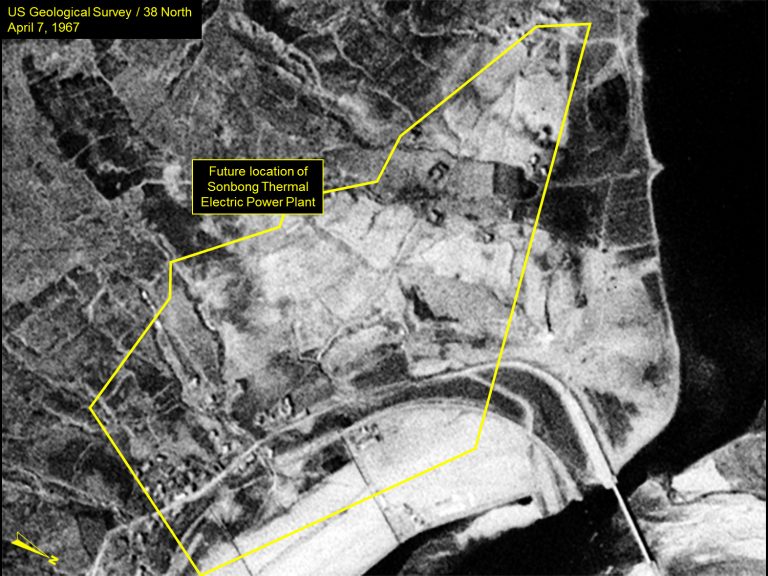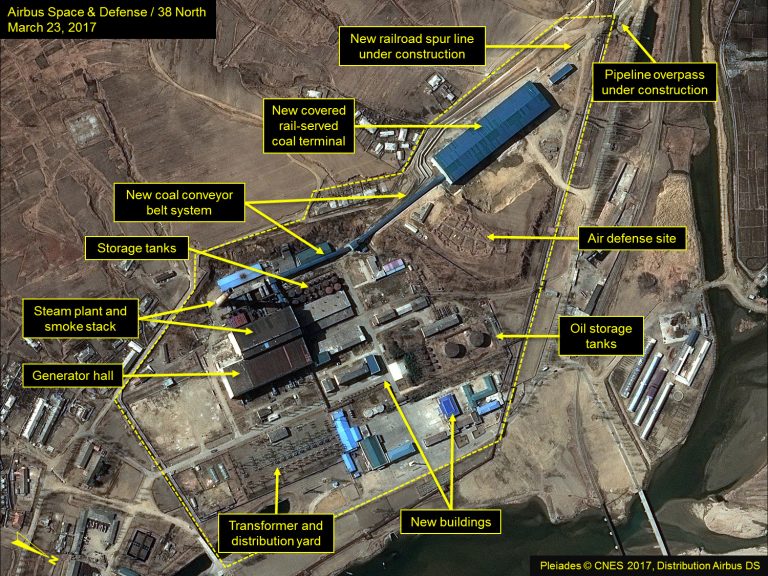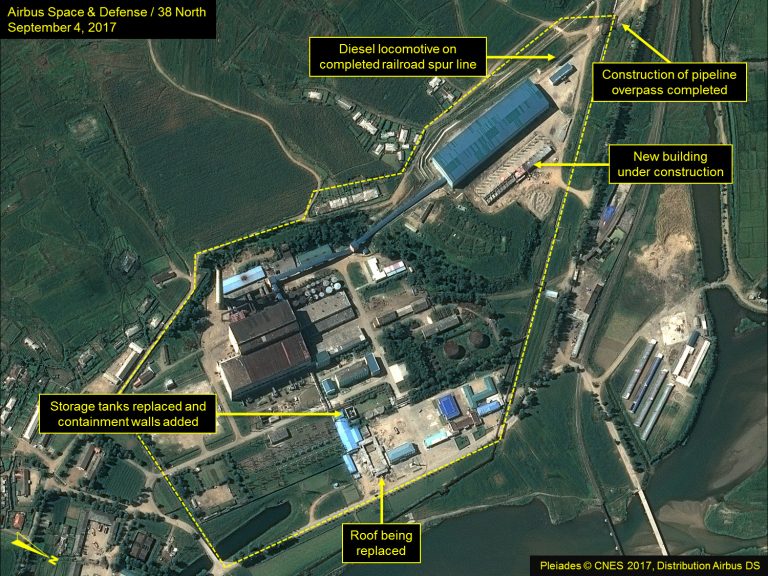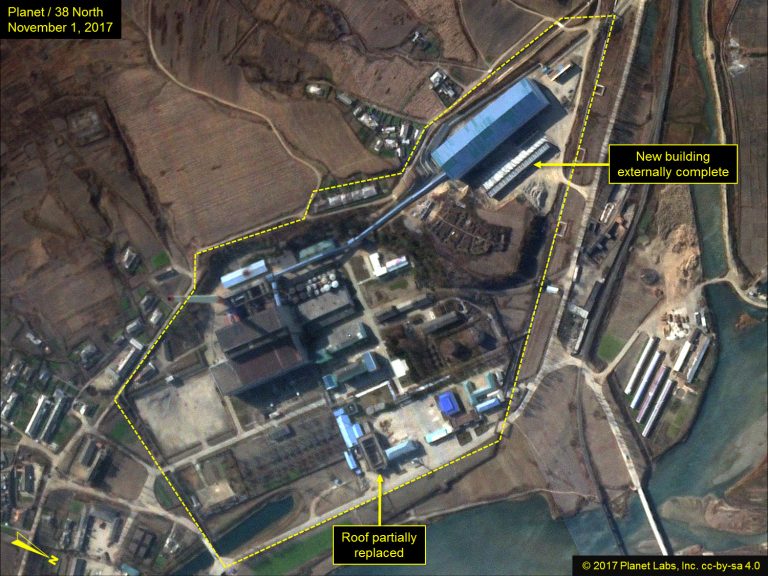Conversion of North Korea’s Sonbong Thermal Electric Power Plant to Burn Coal Nears Completion
In 2015, North Korea began converting the old Sonbong Thermal Electric Power Plant to burn coal, reflecting Pyongyang’s continuing efforts to address its chronic power shortages and achieve energy independence. Recent commercial satellite imagery shows that this project is nearing completion and could start producing energy in the next few months. Although the project will contribute to North Korea’s energy supply, it is unlikely to make a significant impact on Pyongyang’s power problems.
Conversion to Coal
North Korea currently relies on hydroelectric power for over 60 percent of its electricity generation, with coal-fired and, to a lesser extent, oil-fired thermal plants filling in the gap.[1] In recent years, Pyongyang completed two major hydropower projects, the Mount Paektu Songun Youth Power Station and the Huichon Power Station.[2] These projects both conform to Kim Jong Un’s previously stated objective (from his 2014 new year’s speech) of prioritizing renewable energy production.[3] However, hydropower is notoriously vulnerable to periods of low rainfall; a major drought in 2015, for instance, reportedly led to severe power shortages.[4]
Moreover, a majority of North Korea’s power generation capacity was installed in the 1970s and 1980s, with a large portion of hydroelectric facilities dating back to the Japanese occupational period. Due to age and poor maintenance, most of the country’s power plants are in poor or failing condition, and thus are operating inefficiently. A lack of coal mining and transportation infrastructure has also held back the expansion of thermal power generation. North Korea lacks domestic petroleum reserves, but has significant deposits of anthracite and lignite coal, making the conversion of the Sonbong plant from an oil-fired to a coal-fired power plant a logical step in the pursuit of domestic energy security.
Sonbong Plant Nearing Completion
Commercial satellite imagery from April 9, 2017, showed that the laying of the new railroad tracks for the Sonbong facility had yet to be completed, and work was continuing on rerouting a major pipeline over the new tracks. By September 4, the pipeline overpass and railroad spur line were complete and a diesel locomotive can be seen outside the covered coal storage terminal. In addition, recent construction is evident on a new building adjacent to the coal storage terminal, four small storage tanks have been replaced by two new tanks within a containment structure, and a new roof for an engineering/administration building was underway. By November 1, the new building had been externally completed and the new roof on the engineering/administration building was partially complete. Should work continue at its current pace, the facility should be capable of regularly producing electricity in early 2018.
Figures 1-4. Overview of Sonbong Thermal Electric Power Plant shows various construction activities as plant conversion nears completion.
Background Note: The History of the Sonbong Thermal Electric Power Plant
As part of the March 1967 “Economic and Technical Agreement between Korea and the Soviet Union,” the latter agreed to provide assistance on the construction of an oil refinery and associated power plant and oil unloading facility at the port of Unggi (now Sonbong), in North Hamgyong Province, near the border with the Soviet Union. The Sonbong Thermal Electric Power Plant (then known as the “Unggi Thermoelectric Power Plant”) would provide electricity to both the Sungni Chemical Factory (then known as the “Uggni Petroleum Refinery”) and the port city of Unggi. Construction began in early 1972, and the plant began operating—burning heavy fuel oil from the Sungni Chemical Factory—in 1974 with a capacity of 100,000 kW. Its generating capacity was subsequently increased to 200,000 kW in December 1977.[5]
The plant supplied electricity to both the Sungni Chemical Factory and port for over 20 years. However, the dissolution of the Soviet Union in December 1991, compounded by North Korea’s economic collapse and repeated famines from 1994-1998 (known as the Arduous March), resulted in the suspension of operations at the Sungni Chemical Factory in 1995 and termination in 1996 due to the lack of fuel.[6] Concurrently, operation of the Sonbong Thermal Electric Power Plant and the oil unloading facility was also suspended. The power plant would reportedly only operate intermittently during the next 25 years, while the oil unloading facility was converted to general cargo use.
- [1]
North Korea, Global Energy Network Institute, http://www.geni.org/globalenergy/library/national_energy_grid/north-korea/northKoreaCountryAnalysisBrief.shtml.
- [2]
Eric Talmadge, “North Korea in rush to boost electricity supply,” Boston Globe, June 3, 2015, https://www.bostonglobe.com/news/world/2015/06/03/north-korea-rush-boost-electricity-supply/iNmQzZISrNlSmvTpeZcg6O/story.html.
- [3]
Curtis Melvin, “Pyongyang’s Perpetual Power Problems,” 38 North, November 25, 2014, http://38north.org/2014/11/cmelvin112514/.
- [4]
Anna Fifield, “North Korean drought is hobbling the power supply, and the economy with it,” Washington Post, June 21, 2015, https://www.washingtonpost.com/world/asia_pacific/north-korean-drought-is-hobbling-the-power-supply-and-the-economy-with-it/2015/06/21/65e51c02-14ff-11e5-8457-4b431bf7ed4c_story.html?utm_term=.29df521f0c91.
- [5]
“North Korean Industry Infrastructure,” Pukan Sanop, 1997, pp. 230-259; Kim, Yong-yun. “North Korean Chemical Industry,” Pukhan, December 1998, pp. 132-143; and Kim, Chol-hwan. “North Korea’s Science and Technology Levels—An Intensive Analysis,” Sin Tong-a, No. 12, December 1990, pp. 212-228.
- [6]
“North’s Steel, Energy Sectors Face Collapse,” Choson Ilbo, August 22, 1995, p. 31; and Yi, Yong-chong, “Sungni Oil Refinery in North Korea Recently Shut Down,” Chungang Ilbo, November 11, 1996, p. 5.




